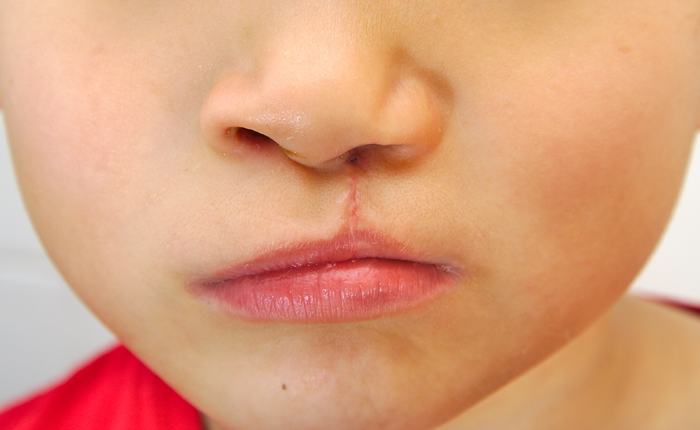Cleft Palate Surgery in Kondapur, Hyderabad
A cleft lip and palate is when a baby is born with an opening in the formation of the upper lip (cleft lip) or in the roof of the mouth (cleft palate). Both these deformities may occur separately or individually. This disformity develops in the baby in its early stages of development inside the mother. It happens when sometimes the left side and the right side of the face and the roof of the mouth do not join or fuse together.
The roof of the mouth is made of the hard palate in the front and soft palate at the back. The hard palate is made up of the bone and the soft palate consists of tissue and muscle. When the cleft is only in the back in the soft palate it is called an incomplete cleft palate and when it runs from the back till just above the gums and teeth, it is called a complete cleft palate.
The cleft lip is repaired early on in the baby only to prevent any complications when they grow up, like speech development, feeding problems, ear infections and hearing.

What is cleft repair surgery?
The cleft repair surgery is done with the aim to close this gap and restore the normal appearance and functioning of the baby’s mouth. Plastic surgery techniques are used to do so.
The cleft lip repair surgery is performed when the baby is about 3 months old. In the surgery, the gap in the baby’s lip is closed providing it with a normal upper lip structure. In this surgery, the baby is given general anaesthesia and the cleft lip is repaired and closed with stitches. On either side of the gap, incisions are made to create folds of muscle and tissue that are drawn and stitched together to close the gap and restore mouth and nose symmetry. The stitches may be dissolvable, if not they are removed after a few days. The surgery may leave a light scar that can fade further over time.
The cleft palate surgery is done when the baby is about 6 to 12 months old. The goal of the surgery is to close the gap on the roof of the mouth, restore symmetry and normal speech. Cuts are made on either side of the cleft to create layers of tissue and muscle that are then carefully positioned to join the hard and soft palate. The soft palate muscles are joined to repair the speech. The gap in the roof of the mouth is closed and the muscles of the palate rearranged. The gap is closed usually with dissolvable stitches.
Why should your child have cleft lip or palate repair surgery?
Cleft lip repair surgery is also known as cheiloplasty and it helps the child in:
- Having a normal mouth appearance and symmetry- formation of cupid’s bow, space between mouth and nose
- Restoring nose symmetry and shape- breathing improves
Cleft palate repair surgery helps in improving the child’s speech as the palate forms the base of the nasal cavity. This base helps in the formation of speech. By repairing the soft palate muscle normal speech development can be obtained for the child.
Additional surgery might be suggested depending on the cause and severity of the cleft to uplift the appearance of the mouth. These are usually done when the child grows up.
The team of specialists and doctors at Apollo Kondapur will suggest the best surgery option for your child.
Request an appointment at Apollo Spectra Hospitals, Kondapur
Call 1860-500-2244 to book an appointment
When should you see a doctor?
The healing process is fairly simple after the surgery. Some antibiotics and pain medication may be recommended. Some risks that you need to be aware of may include:
- Fever above 101 degrees
- Persistent pain and discomfort
- Heavy and continuous bleeding from the mouth
- Dehydration
If any of the symptoms are noticed please call your doctor immediately.
Cleft lip or palate is a common deformity at the time of birth in babies. It can be repaired with surgery that does not have as many risks and helps your child have a normal appearance and growth as they grow up. The surgery is a successful option with no long-term problems.
It may take up to 3 to 4 weeks to heal.
Cleft lip and palate are formed when the baby is inside the mother. It can be due to genes or due to medication, environment, food or supplements that the mother may take during pregnancy.
The cleft lip surgery leaves a small scar above the lip. Dissolvable stitches are used to minimise the scar and it also fades over time. Cleft palate scar is inside the mouth only.
Symptoms
Our Top Specialities
NOTICE BOARD
CONTACT US
CONTACT US
 Book Appointment
Book Appointment


.svg)
.svg)
.svg)
.svg)








